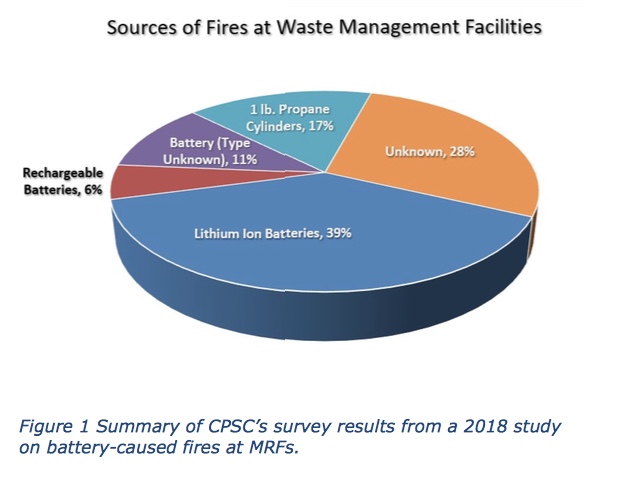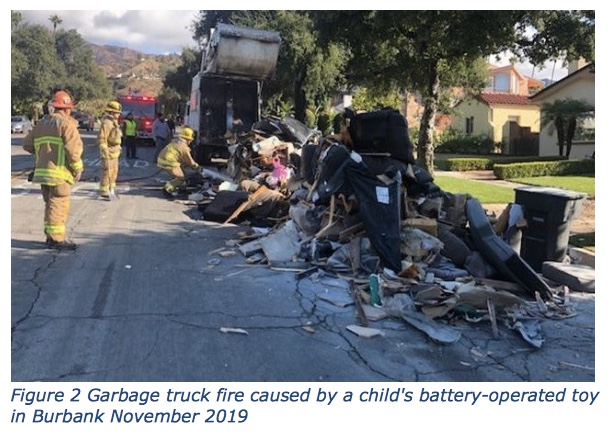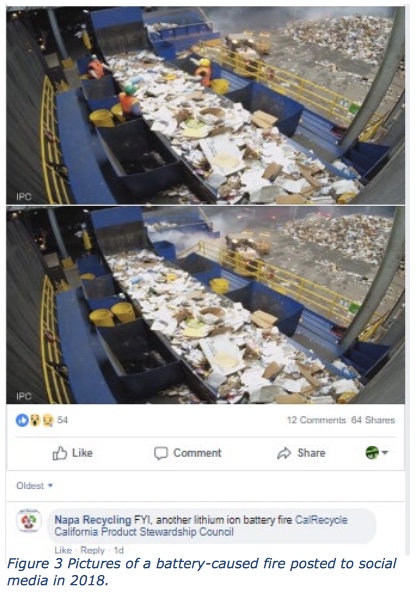Products that contain batteries have become common in every aspect of our lives, powering our phones, computers, cars, and less conspicuously, our wearable technology, greeting cards, e-cigarette pens, and children’s toys. Batteries contain hazardous metals and corrosive materials that, when improperly discarded, pose a serious threat of catching fire. Considered hazardous waste in California, batteries are banned from burial in solid waste landfills and are required by law to be safely disposed at specific collection centers. Yet, batteries continuously end up at waste management facilities and pose fire, health, and safety hazards.1 In order to protect human and environmental health, the California Product Stewardship Council (CPSC) is sharing information on battery fires and proposals for policy reform.
CPSC is a powerful network of local governments, non-government organizations, businesses, and individuals supporting policies and projects where producers share in the responsibility for managing problem products at their end of life. CPSC’s mission is to shift California’s product waste management system from one focused on government funded and ratepayer financed waste diversion to one that relies on producer responsibility in order to reduce public costs and drive improvements in product design that promote environmental sustainability.
Dangers of Mismanaged Batteries at End-of-Life
Due to the hazardous metals and corrosive materials that batteries contain, California classifies batteries as hazardous waste and bans them from solid waste landfills. When consumers are done with their loose batteries and portable electronics, they must collect, sort, and ultimately find an appropriate disposal option. Unfortunately, California currently lacks a streamlined and convenient collection and recycling system for most batteries and batteries embedded in products, raising the risk of mismanagement and environmental catastrophe.

The United Nations summarizes the 8 ways Lithium-ion batteries can catch fire:
1. Low ambient pressure
2. Overheating
3. Vibration
4. Shock
5. External short circuit
6. Impact
7. Overcharge
8. Forced discharge
Once batteries end up in waste management facilities, they are often exposed to conditions that are ideal for battery ignition. Collection trucks dump loads onto concrete “tipping floors” where damaged batteries are then exposed to oxygen.2 At a Portland facility, a fire started when volatile chemicals interacted from a broken battery, likely from a battery operated drill or similar power tool.3 Fire Roverreported fires caused by loaders driving over batteries, shredders mincing batteries, and the presence of materials that start a reaction nearby, such as fireworks and fertilizers.4 Battery fires endanger the lives of facility workers and fire fighters, release pollutants into the environment, and cause costly damage and disruption to vehicles, equipment, and facilities.

According to a study published by MDPI, “no other substance or material has ever comparably endangered the whole waste industry” than batteries.5In 2020 alone, Fire Rover estimates that waste management facilities in the U.S. and Canada experienced 2,620 total fires, nearly seven times the number of fires reported to officials. 4That same year, 18 states saw an increase in reported facility fires and experts expect that trend to continue.4
Battery-Caused Fires are Increasing at Waste Management Facilities Nationwide
In 2018, CPSC surveyed waste facilities across California and found that 83% of the 26 respondents experienced a fire in the last two years, with 65% of fires caused by batteries.6 In the last three years since the original battery fire publication, CPSC has heard from several local government waste managers, haulers, and processors that not all fires in their facilities are reported to fire departments and insurance companies due to the ability to quickly extinguish these fires.
The lithium-ion battery market is expected to reach $98 billion by 2025 and as more battery types and battery-embedded products enter the waste stream, waste management facilities and collection trucks across the United States have been experiencing an increase in fires, most of them caused by batteries.7Nationwide, about one facility every month is destroyed due to battery fires.2 At one California facility, 11 batteries were found in the waste stream on average each hour.1
Solutions to Reducing Battery-Caused Fires
In 2021, an NBC News investigation found thousands of listings for loose batteries from multiple major retailers, including Walmart and Amazon, without accurate information on safe end- of-life management.8 Residents need convenient access to collection options and education on how to participate in safe battery management to reduce the number of batteries improperly entering the waste stream. A 2010 study published by CPSC found that 59 percent of Californians surveyed were aware of the disposal ban on batteries, but 56 percent still threw them in the trash.9

Safe disposal of batteries at their end-of-life could spark circular use, with innovation opportunities to improve battery lifespan and recycling processes. Battery specialists and environmentalists give a long list of reasons to recycle batteries, including the valuable and finite minerals which could be reused, further reducing toxic environmental impact and supporting economic growth.10
Additional collection sites, transportation, and recycling of post-consumer batteries will cost money, but will ultimately reduce the risks and costs of damage experienced by waste management facilities. The cost burden of battery management has already expended local government resources and the industry is called on to take responsibility for the batteries and battery-embedded products they sell.
Policy Reform
California is leading the charge to reduce the cost and burden of mismanaged batteries on the solid waste industry through policy reform. California Senator Josh Newman, representing district 29 (Fullerton), introduced SB 289: Better Battery Recycling and Fire Risk Reduction. In addition to reducing fire damage risk, this bill will alleviate collection and handling costs to local governments by requiring producers to establish a stewardship program for a statewide battery collection and recycling program. The bill would require free and convenient collection bins at retail locations for the purpose of accepting loose and embedded batteries for all common household battery types. For the average consumer, it can often be difficult to distinguish between chemistries of batteries and the proposed bill would create a consumer outreach and education campaign to further encourage the proper disposal of all batteries.
For more information, visit www.calpsc.org.
Sources
1. SB 289 (Newman): Better Battery Recycling and Fire Risk Reduction Fact Sheet
2. Recycling Plants are Catching on Fire, and Lithium-ion Batteries are to Blame- The Verge, 2/28/20 3. Lithium ion battery causes of recycling center fires- Portland Press Herald, 2/3/21
4. 4th Annual Reported Waste & Recycling Facility Fires US/CAN- Fire Rover, 3/2021
5. Lithium-Ion Batteries as Ignition Sources in Waste Treatment Processes – A Semi-Quantitate Risk Analysis and Assessment of Battery-Caused Waste Fires- Processes, 12/29/20
6. Survey Results Regarding Fires in the Waste Management Industry- CPSC, 4/9/18
7. Why insurance costs are on the rise for recycling companies- Resource Recycling, 3/16/20
8. Experts warn against buying loose lithium ion batteries that cause fire hazard- TODAY, 2/15/21
9. Household Battery/CFL Take Back Program: Telephone Survey Report- CPSC, 4/2010
10. It’s time to get serious about recycling lithium-ion batteries- Chemical & Engineering News, 7/14/19
